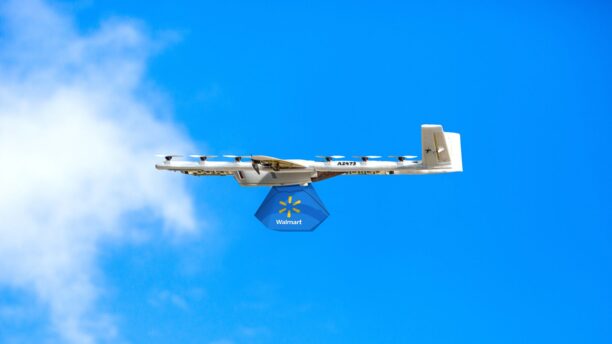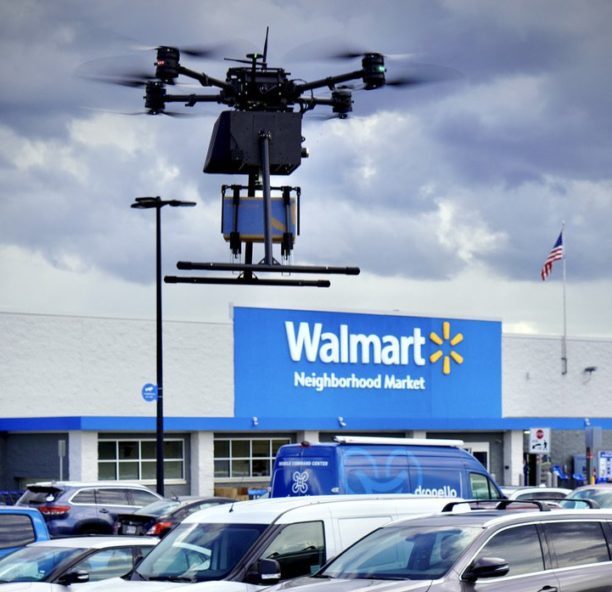Shifting Partnerships Highlight Challenges in Building Cost-Effective and Scalable Drone Delivery Systems
Walmart’s recent decision to end its partnership with DroneUp marks a significant moment for the drone delivery industry. The retail giant terminated its collaboration with the logistics provider and reportedly divested its stake in the company. This move reflects both the evolving dynamics of drone delivery models and the challenges of scaling cost-effective operations.
The partnership, established in 2021 after promising COVID-19 test kit delivery trials, faced inevitable operational hurdles. Despite initial success, the collaboration struggled with high costs and logistical barriers. The split underscores the complexities of sustainable drone delivery, even as the technology advances.
Walmart’s New Drone Delivery Strategy
Although Walmart has parted ways with DroneUp, it continues to invest in drone delivery through partnerships with Wing and Zipline. Walmart recently expanded its delivery network across the Dallas-Fort Worth area, aiming to cover up to 75% of the region. This pivot positions Walmart as the U.S. retailer with the broadest drone delivery footprint.

All of the major drone delivery players have taken different approaches to the operational problems. Wing, a subsidiary of Google parent Alphabet, operates in some areas by placing its drones on rooftops of shopping malls, offering delivery services to nearby homes. Zipline, on the other hand, has adapted its overseas experience —delivering medical supplies in countries like Rwanda—to U.S. retail operations.
Walmart’s strategy shift illustrates the need for diverse approaches to drone delivery, as different providers offer unique solutions tailored to specific markets and operational challenges.
The Challenges of Drone Delivery Models
The Walmart shift highlights a central issue in drone delivery: achieving cost-effective scalability. Tech giants like Amazon and others have made significant investments in the sector. Still, creating a model that balances costs and customer expectations – and meets regulatory requirements – has proven difficult.
Amazon and Wing both developed their own aircraft, an investment-heavy approach that has required years of R&D. Amazon works to deliver it’s own products, which could require even more investment in developing local distribution centers to bring product closer to consumers. Companies like Wing and Flytrex focus on local delivery from hubs like malls or fast-food chains, potentially reducing infrastructure demands.
Zipline’s approach, which looks significantly different than any of the other models, is another example of experimentation with drone logistics. However, details on the costs per delivery remain scarce.
Customer willingness to pay is another challenge. While drone delivery offers convenience, few customers are likely to pay $10–$15 per delivery, making affordability a key factor for widespread adoption.
Looking Ahead: What’s Next for DroneUp and Walmart’s Partners
Despite losing Walmart’s backing, DroneUp is poised to leverage its newly acquired Part 135 FAA certification for expanded commercial operations. The certification could allow the company to explore alternative revenue streams or partnerships that fit its operational strengths.
Meanwhile, Walmart’s collaboration with Wing and Zipline provides a fresh perspective on viable drone delivery models. These partnerships demonstrate how strategic pivots and diverse operational frameworks might overcome the obstacles that prevent drone delivery from operating at scale.
As the drone delivery industry matures, companies must navigate evolving regulations, operational costs, and consumer expectations. The Walmart-DroneUp breakup serves as a reminder that no single model has yet proven to be the definitive solution. However, continued innovation and partnerships may pave the way for sustainable and scalable drone delivery services in the future.
Want DRONELIFE news delivered to your inbox every weekday? Sign up here.
Read more:
- DroneUp, Walmart close drone delivery sites in 3 states to focus on D/FW operations
- Walmart Expands Tech-Driven Services with Drone Deliveries and AI Assistant
- Sky’s the Limit: Walmart’s Ambitious Drone Expansion with Wing and Zipline Set to Transform Dallas/Fort Worth Metroplex Delivery Landscape
Miriam McNabb is the Editor-in-Chief of DRONELIFE and CEO of JobForDrones, a professional drone services marketplace, and a fascinated observer of the emerging drone industry and the regulatory environment for drones. Miriam has penned over 3,000 articles focused on the commercial drone space and is an international speaker and recognized figure in the industry. Miriam has a degree from the University of Chicago and over 20 years of experience in high tech sales and marketing for new technologies.
For drone industry consulting or writing, Email Miriam.
TWITTER:@spaldingbarker
Subscribe to DroneLife here.
